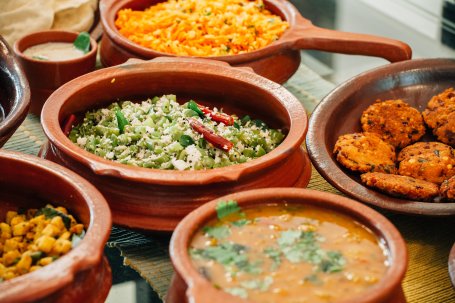When I think of my mom I remember her soft white belly. It is so strange that when I have to summon a memory of my mother this is what comes up. Not her face, not her words, not some laughter moment. Her belly. She would be drying my hair and I would succumb to the assault of her fingers while she held my head in a vice-like grip while the thin kerala tortu would be buffing my head hard. Nose pressed on her belly, arms circling her waist I would stay there, hoping it would go on. She would stop in between, check my scalp and hair and then go on if she was not satisfied. I would be happy to let it go on for hours at the cost of my all my hair being violently ripped off in the cause of its drying. I was happy. It was the only way I got to hug my mother. My mother was not the hugging, kissing kind.
My mother’s hugs came through her cooking. Some of the tastiest food I’ve eaten so far are what my mom conjured up in our badly-lit, pokey kitchen. When I think of that kitchen I remember the second-hand refrigerator that leaked water through the day, because the freezer door hung loose. It was like an old man, humming loudly in disgruntlement, drool dripping steadily out of his toothless mouth, always unhappy. I remember opening this tiny fridge and seeing the poor freezer, its cavernous mouth packed like an igloo, icicles forming and un-forming, dripping.
In the early mornings—and my mother was up at 4.30 am—the kitchen would be in full swing. Five dabbas had to be packed and everyone who left would leave after they tucked into an elaborate breakfast. To date, all of us sisters carry this tradition forward—an elaborate breakfast is what you will always get in our homes. We had two hobs and both would have something cooking on it. We had a stove and on that—usually—something else would also be boiling. My mother would be perched on a squat stool, hulking over the grinding stone in which she would be… well… grinding. Usually the masala—coconut, and roasted red chilies and whatever else went into the masala of the recipe, itself was fragrant. The mori—the washing area—with its chipped tiles, would be loaded with utensils.
On the ceiling would hang a bare, zero-watt bulb, doing nothing to kill the gloom of dawn. Our kitchen was always a warm place. In summer, it used to be humid, hot and unbearable. No matter what the season was, my mother’s schedule was the same; her agenda for the day, usually, the same. And no matter what the chaos was, the space where food was cooked in our home always smelt divine.
So when I think of my mother I remember her smooth, alabaster, soft belly. And after that I think of the divine food she created. The pickles, the curries, the chutneys, the payasaam, the fragrant rice, the coconut laced stews, the cloud-soft idlis, and the fluffly appams with their golden crisp lace, the molagapodi, coconut oil and cheryaulli chamandi, the puttu and the kadla, the mutton ball curry and the liver fry and the parpu and the pachadi, the fish curries. The sambar and the curd-rice and the French toast, the biryanis and the prawn fry.
The kitchen never closed. Sunday were a feast of biryani and mutton cutlets. When meals were done, in-betweens were conjured. If breakfast was idli, dosa, adda, puttu, appam with their respective accompaniments (sambar, coconut chutney, vegetable stew) along with a serving of eggs, in-betweens were poha, upma, parpuvadas, home-style bhel made of red-rice poha and sugar-glazed onions, french toast, avil (roasted red rice poha eaten with melted jaggery and chopped bananas), bondas, kozhakutta, or nendrapazham (kerala bananas) fry. (I have no idea why, despite all this, we were always hungry.)
When the meals and the in-betweens were done, there was always dry snacks to be made and stored in steel containers, and remade and refilled. And what about the pickles and the papadams and the jams and the ketchups and the squashes? Everything we ate, my mother made it at home. It was exhausting to watch her plan. When the tomato season was on she bought kilos of tomatoes and our peripheral vision was filled with pureed tomatoes and the scent of gram masala. During the peas season, piles of peas were shelled patiently, boiled, and stored. Summers were long days on the terrace, turning the length of pappadam that she had laid for drying, or the mangoes she had bought, chopped and left on old cotton sarees to dehydrate. We took turns to turn these and to shoo off the crows. Everything in abundance was either, cooked, or pickled, or marinated in vinegar and stored.
I never learnt to cook from the woman who hugged and kissed us through food. I think I know why.
Cooking was elaborate, glorious and revered. Even the masalas she used (still uses) were freshly ground. She would shrivel you with her eyes, if you suggest using market-ready masalas. And we still have chattis and cast iron kadais and frying pans in my mother’s home. Nothing is pressure-cooked. Everything was/is soaked, (the water of the soakings used to water plants, the peels of her kitchen kept aside to be used as mulch for her potted plants), washed and cooked slowly in their juices in earthen ware. Still is. Food, and love and worship all happened in our kitchen. Still does. It was too intimidating for me. God bless her.
I decided, instead, that it was impossible to compete with such reverence. Why be another high priestess of a kitchen when I would much rather be a devotee. I eat. I inhale the fragrances, I shut my eyes in pleasure.





